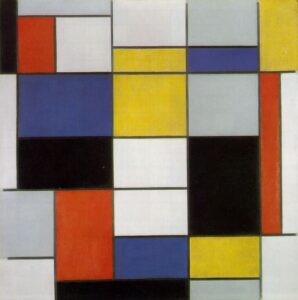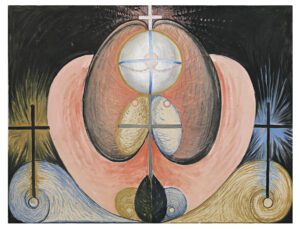
The Tree A c.1913 Piet Mondrian 1872-1944 Purchased 1977 http://www.tate.org.uk/art/work/T02211
Nancy Nesvet

The exhibition of Hilma af Klint and Mondrian pairs two artists who began as botanical and landscape painters but delved into abstractions based on combining spirituality with natural beauty. For Hilma af Klint, her tall architectural paintings included symbols of the folklore and folk patterns of her native Sweden, while Piet Mondrian’s vastly simplified work was based on successions of colors with which he claimed to spiritually connect — going off the canvas, like the water in the Netherlands, and the never-ending latitude-longitude lines circling the earth. While I saw the lone flower, centered, reaching up to the sky in af Klint’s paintings, Mondrian’s early paintings were much more about landscape, horizontally oriented, with areas of color denoting natural landscape features. Mondrian’s, even at this point, were divided by hard-edged lines, whereas af Klint’s paintings featured curves and circles, predetermining her later work. However, those connections, with their commitments to theosophical principles were the only valid juxtapositions I saw in their work and wondered at the intention to pair them.
Only months after the ending of the 2022 Venice Biennale, curated by Cecilia Alemani, and based on her readings of Leonora Carrington’s The Milk of Dreams and vast interest in surrealism and the inclusion of bodies that are different and changing in the biennale, the work of Hilda af Klint in this exhibition continues relation of earth, flora and fauna realizing that bodies, especially of women and animals are changing, making this artist’s work relevant today. For Hilma af Klint, those changes are effected by the influence of nature; for Cecilia Alemani, this author believes that she sees technology and climate bringing about change. But both artist and Curator bring to their audience the changes, whether beneficial or devastating that af Klint saw in the early twentieth century, and that we see now.
No one writing in the catalogue or about this exhibition has yet included af Klint in the annals of ecofeminism, perhaps because the term hadn’t yet been used, but the work clearly not only stems from both feminism, including group participation and decisions made by the group of women producing it, with full credit to the group, but also stems from a concern for nature, and an attempt to literally communicate with nature, finding a language to do so. The influence of Rudolf Steiner and Madame Blavatsky as noted in the catalogue brought theosophy to the attention of Hilma af Klint, and she explored its principles and the ongoing structure of life forms to her work. But she went far beyond theosophy as a discipline, attempting to answer questions posed through the language of image making. As well, af Klint, in feminizing her work, pays heed to patterns and symbols used in women’s textile design and embroidery but that also honor women’s folk traditions. Her images of trees and of nature, produced and fed by the earth, communicate with other natural features and with people. Like the thesis presented in The Hidden Life of Trees where the natural ecosystem and trees communicate with each other, Hilma af Klint is interested in Yggdrasil, the world tree of Norse mythology, in her W Series, The Tree of Knowledge of 1913-15. Af Klint’s spiral, used extensively throughout her work, is also nature’s symbol, appearing in the plant and animal kingdom but also referring to that invisible world that she hints at, whether in the inner chambers of the spiral or the soil dividing the roots of the tree, from the leafy branches above.

1908
Olja p duk
102,5 * 132,5 cm
HAK078
© Stiftelsen Hilma af Klints Verk
It is this insistence on the spiritual, the invisible hand guiding the hand of the artist, and the unseen dictating the mortal appearance of the work and the laws of nature as in On the Viewing of Flowers and Trees 1922 that corroborate Klint’s use of “plant as meditative to express a spiritual bond with nature.” (Catalogue, pg. 11).
Looking critically at work produced by af Klint’s acknowledged and credited team of women artists, I do wonder if, in this age, when we finally acknowledge women’s contributions to the art world, if the circular, curved structure, often including folkloric symbols from women’s handicrafts, and shapes reminiscent of vulva and breasts, is not only spiritually inspired, but intentional. As af Klint painted her tallest work, the Temple, with shapes from a woman’s body, we cannot escape remembering that the body is the temple of the soul, the soul that leads us back to af Klint’s philosophy about the soul controlling emotion, and everlasting, and theosophy’s concern with that soul. Yet Laura Stamps notes in the catalogue to the exhibition (pg. 87) that not only did Mde. Blavatvsky and Henry Olcott seek to combine science, philosophy and religion as “a method whereby the soul could purify itself” passing successively through stages of purity as it grew closer to the divine, but also attempted to show how society evolved, spiritually growing as the earth evolved, growing ever closer to a new spiritual age, showing in af Klint’s WUS Seven-pointed star series. Group VI, The Evolution (1908). In the eighth iteration in the series, the human soul resides in a snail; once people no longer connect physically but only spiritually, they fuse into a pure unity, apparent in Blue Book 6: The Evolution (no date). Going farther with the Five, a Christian spiritualist collective including af Klint, Anna Cassel, Mathilde Nilsson, Cornelia Cederberg and Sigrid Hedman created automatic drawings incorporating floral forms, intersecting lines, spirals, and leaf shapes seeking knowledge of the universe through divine revelation revealed by the teachings of the spirits. Those drawings influenced and became the basis of af Klint’s larger drawings and paintings incorporating bodily shapes, spiral, circular, and biological forms. Later, hand-painted photographs are made of a single image of two parts, not mirror images, but closely allied. This mirroring of these erotic images is repeated extensively throughout her oeuvre, seen in No. 3, No. 6, No. 8 and No. 9, all painted in 1908.
If we look at another “temple” produced a score of years later, by Leni Richtenstal featured in “Metropolis,” we do not see curves or shapes reminiscent of women’s bodies, but rather a “masculine” hard-edged linear skyscraper. Af Klint’s art is peaceful, and colorful, with pastel-like colors, soft but tall, bold but bright. Yet the reliance on the symbolism of Scandinavian folkloric tradition and iconography coupled with the emphasis on purity and spirituality keeps me from fully appreciating the beautiful curvilinear, and yes, feminine aspects of the work. I know what comes thirty years later. Writings of the group surrounding Hilma af Klint and the theosophists try to merge science of the period with art, but avoids, because there is no awareness yet, the detrimental and disastrous effects of the science being produced and discovered.
We cannot put ourselves into the mindset of the theosophists, of af Klint’s group but we can recognize the beauty of her work, and see the terrible beauty that transpired later, in the land where Alfred Nobel discovered the power to destroy, unbeknownst to those creating art in the earliest decade of the twentieth century.
HILMA AF KLINT & PIET MONDRIAN
FORMS OF LIFE Tate Modern, until 3rd September 2023

